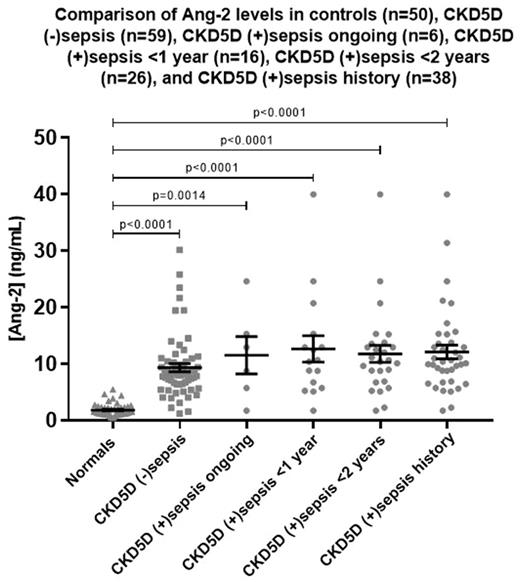Abstract
Introduction: Infection is the second most common cause of death among patients with stage 5 chronic kidney disease undergoing hemodialysis (CKD5D). Sepsis, defined as life-threatening organ dysfunction due to dysregulated host response to infection, accounts for more than three-quarters of all such cases. Sepsis has implications in worsening morbidity and mortality rates for CKD5D patients. Even after sepsis resolution, there are residual pathological and biochemical irregularities caused by infection which result in a diminished quality of life for survivors.
Circulating angiopoietin-2 (Ang-2) levels has been reported to be upregulated in a variety of inflammatory conditions, including sepsis and CKD5D. Ang-2 is an angiogenic growth factor implicated in endothelial dysfunction and inflammatory processes. We hypothesize that elevated Ang-2 levels in CKD5D patients will be further amplified in those with a previous history of sepsis. Measuring Ang-2 levels in these conditions may lead to a broader understanding of the pathogenesis of sepsis and its long-term consequences in the CKD5D patient population.
Methods: Plasma Ang-2 levels in CKD5D patients (n=97) and normal controls (n=50; George King Bio-Medical, Inc., Overland Park, KS) were measured using the Ang-2 sandwich ELISA (R&D Systems, Minneapolis, MN, USA) method. Of the 38 CKD5D patients who had a past medical history of sepsis, 6 had ongoing sepsis upon the blood draw date, 16 were diagnosed <1 year prior, and 26 were diagnosed <2 years prior. GraphPad Prism v7 was used to perform Mann-Whitney t-tests and Kruskal-Wallis non-parametric ANOVA to compare CKD5D patients with sepsis diagnosis to non-sepsis CKD5D patients.
Results: Mean Ang-2 levels were markedly higher in CKD5D patients with a previous sepsis diagnosis at all time intervals (11.55 ± 3.29 ng/mL CKD5D (+)sepsis ongoing, 12.67 ± 2.34 ng/mL CKD5D (+)sepsis <1 year, 11.80 ± 1.51 ng/mL CKD5D (+)sepsis <2 years, 12.14 ± 1.22 ng/mL CKD5D (+)sepsis history) than in CKD5D patients with no sepsis history (9.38 ± 0.74 ng/mL). Mann-Whitney t-tests showed statistical significance when comparing CKD5D patients with no sepsis history to those diagnosed <2 years prior to the blood draw date (p=0.0432), as well as to those with a sepsis diagnosis at any time in their medical history (p=0.0138). In comparison to controls, ANOVA reported significantly elevated Ang-2 levels in CKD5D patients (-)sepsis (p<0.0001), CKD5D (+)sepsis ongoing (p=0.0014), CKD5D (+)sepsis <1 year (p<0.0001), CKD5D (+)sepsis <2 years (p<0.0001), and CKD5D (+)sepsis history (p<0.0001).
Conclusion: Circulating Ang-2 levels are upregulated during sepsis and has been correlated to the severity of this disease, as well as mortality. Additionally, Ang-2 levels are raised in CKD5D. This study found a general trend demonstrating Ang-2 levels to be continually elevated in CKD5D patients following a past history of sepsis. Understanding the upregulation of Ang-2 in CKD5D may provide insight into the pathophysiology of sepsis within the CKD5D population, and may be of prognostic value in the management of these patients.
No relevant conflicts of interest to declare.
Author notes
Asterisk with author names denotes non-ASH members.


This feature is available to Subscribers Only
Sign In or Create an Account Close Modal